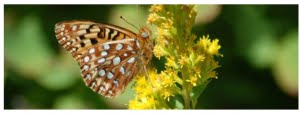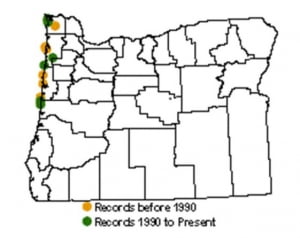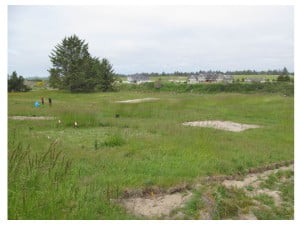
Adaptive Restoration in Oregon’s Coastal Prairies, Clatsop Plains

Adaptive management is a framework for making decisions based on the assessed impacts of treatments, the results of which are formed into a flexible management plan with modifications as the plan progresses. Adaptive habitat restoration requires novel approaches and all-encompassing solutions to improve the integrity of ecosystems and their surrounding environments. Coastal prairie ecosystems are a prime target for restoration since they have lost the majority of their original range over the past 150 years. The Clatsop Plains study is a collaborative effort testing adaptive management methods for restoring coastal prairie habitat, conducted by the Institute for Applied Ecology (IAE), the North Coast Land Conservancy (NCLC), the National Park Service (NPS) and the US Fish and Wildlife Service (USFWS). Dune ecosystems and coastal prairies historically extended from northwest Washington to northern California. Today, only about 1% of its historic range remains and much of the coexisting flora and fauna have consequently declined.
Several factors have contributed to the reduction of coastal prairie habitats including increased anthropogenic influence, the introduction of exotic species, and climate change. Coastal prairie communities have experienced rapid habitat loss due to conversion to housing developments and areas for recreational use. Agriculture has introduced many exotic species to coastal prairies such as tall fescue (Schedonorus arundinaceus), sweet vernal grass (Anthoxanthum odoratum), and orchardgrass (Dactylis glomerata). Scotch broom (Cytisus scoparius) was initially brought to the western U.S. as a decorative garden shrub and is now a widespread introduced species in coastal prairies, outcompeting native plants. While human impacts may be detrimental to the survival of coastal prairie communities, human influence can be incorporated into the conservation of surrounding ecosystems.

A rapidly changing climate is another obstacle coastal prairies face and will continue to be an important consideration for future restoration. This ecosystem relies on a maritime climate and increased unpredictability of precipitation and temperature cycles make it difficult for sensitive plant communities to adjust. Shoreline erosion and coastal flooding from rising sea levels may also play a role in the future status of coastal prairies. The Fifth Assessment Report from the IPCC suggests that the global mean sea level could rise by between approximately 0.5 to 1 meters (IPCC 2013), which could have profound implications for coastal ecosystems.
A major consequence of habitat fragmentation is loss of regional biodiversity. Oregon coastal prairie sub-habitats include salt-spray meadows and stabilized dunes; both are critically important to the endangered Oregon silverspot butterfly (Figure 1; Speyeria zerene hippolyta).The Oregon silverspot’s life cycle relies on the hookedspur violet (Viola adunca), a small violet that predominantly exists in coastal prairies. Their historic range is from northern Washington south to northern California (U.S. Fish & Wildlife Service 2013). The current distribution of the Oregon silverspot in Oregon is shown in Figure 2. Now mostly extirpated because of fragmented habitat, a multi-agency collaborative effort has formed to restore the Oregon silverspot back to portions of its historic range. For example, the adaptive restoration in the Clatsop Plains region actively engages many partners including the NCLC, NPS, USFWS, Natural Resource Conservation Service and the Nature Conservancy.
Restoration of coastal areas requires consideration of the historical disturbance regimes at work in a functioning grassland ecosystem. Coastal prairies rely partly on disturbance to ensure growth of native grasses and limit encroaching shrubs. Historic disturbance included fire and shifting sands from coastal winds (Heady et al. 1977). Now, since these processes no longer occur at the same intervals, land management strategies could incorporate mimicking disturbance into their restoration objectives.

In the Clatsop Plains study, three different treatments and a control were used to evaluate the effectiveness of each method on prairie restoration (Figure 3). The treatments included herbicide application, topsoil removal, and topsoil inversion. No treatments were applied to control plots, but they were exposed to the same environmental conditions as all other treatments (weather, climate, herbivory, etc.) to create a basis for comparison. Glyphosate and Imazapyr, both broad spectrum herbicides typically used for weed control, were alternately applied to the herbicide plots to assess the impact of exotic species in competition with native plants. For topsoil inversion, vegetation and soil were turned over to mimic dune-soil conditions where nutrient rich soil layers move under or over nutrient poor layers. Previous studies in central California and northwest Wales, UK, show that mimicking natural disturbance regimes of blowing sand and dune creation can be effective in increasing establishment of coastal prairie species (Jones et al. 2010, Boisson et al. 2006). Topsoil removal excavates nutrient rich topsoil and leaves behind a sandy, nutrient poor layer; this encourages colonization through reseeding post soil removal.
In the Clatsop Plains study, several acres have been treated and an adaptive management decision-making framework will guide the remainder of the restoration process, where combinations of treatments will be implemented over a larger scale. Conducting more experiments that factor in a rapidly changing climate and attempt to mimic natural disturbance regimes allows land managers and researchers to gain a more expansive knowledge base and tool set to conserve biodiversity and reduce habitat fragmentation. Ultimately, restoring the integrity of coastal ecosystems improves upon the services these ecosystems provide in a way that benefits the natural and human-influenced ecology as a whole.
By Cecilia Welch, Connor Whitaker, and Sara Newman, 2015 IAE/NPSO Interns
References
Boisson, E., K.D Holl, S. Anderson, E. Corcket, G.F. Hayes, F. Torre, A. Peters, and T. Dutoit. 2006. Effect of seed source, topsoil removal, and plant neighbor removal on restoring California coastal prairies. Restoration Ecology: 14:4:569-577.
Heady, H.F., T.C. Foin, M.M. Hektner, D.W. Taylor, M.G. Barbour, and J.W. Barry. 1977. Coastal prairie and northern coastal scrub. In: Barbour MG, Major J, editors. Terrestrial vegetation of California. Sacramento, CA: California Native Plant Society. p 733-760.
IPCC, 2013: Summary for Policymakers. In: Climate Change 2013: The Physical Science Basis. Contribution of Working Group I to the Fifth Assessment Report of the Intergovernmental Panel on Climate Change. [Stocker, T.F., D. Qin, G.-K. Plattner, M. Tignor, S.K. Allen, J. Boschung, A. Nauels, Y. Xia, V. Bex and P.M. Midgley (eds.)]. Cambridge University Press, Cambridge, United Kingdom and New York, NY, USA.
Jones, M.L.M., K. Norman, and P. M. Rhind. 2010. Topsoil inversion as a restoration measurein sand dunes, early results from a UK field-trial. Journal of Coastal Conservation: 14:139-151.
U.S. Fish & Wildlife Service 2013. Species fact sheet: Oregon silverspot Butterfly. Oregon Fish and Wildlife. Accessed: 23 July 2015. http://www.fws.gov/wafwo/species/Fact%20sheets/Oregon%20Silverspot%20Draft%20Final.pdf